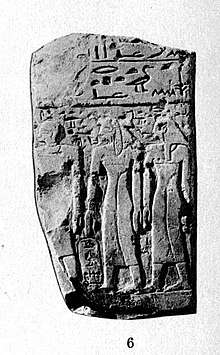Sobekemsaf (queen)
Sobekemsaf (sbk-m-z3=f)[2] was an ancient Egyptian queen of the 17th Dynasty. She was the wife of pharaoh Nubkheperre Intef and sister of an unidentified pharaoh, probably Sekhemre-Heruhirmaat Intef, Sobekemsaf II or Senakhtenre Ahmose.[3][4]
| Sobekemsaf Queen consort of Egypt | |
|---|---|
 Stela depicting queen Sobekemsaf (center) along with other relatives.[1] | |
| Dynasty | 17th Dynasty |
| Pharaoh | Nubkheperre Intef |
| Father | possibly Rahotep |
| Mother | unnamed queen |
| Sobekemsaf in hieroglyphs |
|---|
Her name ("Sobek protects him"[5]) is grammatically masculine. Although a female version of the name (sbk-m-z3=s)[5] did exist, the queen is named Sobekemsaf in all sources, so it was not an error on the scribe's part, but she was probably named for an ancestor.[6] Masculine names for females were not uncommon during the Second Intermediate Period.[7]
She is mentioned on a bracelet and a pendant, now both in the British Museum,[2] and on a stela found in her family's hometown Edfu (Cairo CG 34009).[8] The stela, belonging to an official called Yuf dated to the 18th Dynasty, mentions reconstruction of her tomb.[9] Another stela, also from Edfu (Cairo JE 16.2.22.23), depicts queen Sobekemsaf along with other relatives;[1][10] the stela names the queen's sister Neferuni and their mother, whose name is lost.
Sobekemsaf's titles were: King's Wife (ḥm.t-nswt), Great Royal Wife (ḥmt-nỉswt wr.t), United with the White Crown (ẖnm.t-nfr-ḥḏ.t), King's Daughter (z3.t-nỉswt), King's Sister (zn.t-nswt).[2]
Sources
- Engelbach, Reginald: "Steles and tables of offerings of the Late Middle Kingdom from Tell Edfû". Annales du Service des antiquités de l'Egypte 22 (1922), plate 1, no. 6
- Grajetzki, Wolfram. Ancient Egyptian Queens: A Hieroglyphic Dictionary. London: Golden House Publications. ISBN 0-9547218-9-6 (2005), p. 44
- Dodson, Aidan & Hilton, Dyan. The Complete Royal Families of Ancient Egypt. Thames & Hudson. ISBN 0-500-05128-3 (2004), p.117
- Dodson & Hilton, p. 118
- Grajetzki, p. 304
- Polz, Daniel: Der Beginn des Neuen Reiches. Berlin & New York, Walter de Gruyter GmbH, 2007. ISBN 978-3-11-019347-3 p. 39
- Ranke, Hermann: Die ägyptische Persönennamen, Band II, p. 4
- Engelbach, p. 116
- Breasted, James H.: Ancient Records of Egypt. Vol II, Chicago 1906, pp. 44-46 nos. 109−114
- Polz, Daniel: "The Territorial Claim and the Political Role of the Theban State", in: Forstner-Müller & Moeller (eds.), The Hyksos Ruler Khyan and the Early Second Intermediate Period in Egypt: Problems and Priorities of Current Research. Proceedings of the Workshop of the Austrian Archaeological Institute and the Oriental Institute of the University of Chicago, Vienna, July 4 – 5, 2014, p. 229